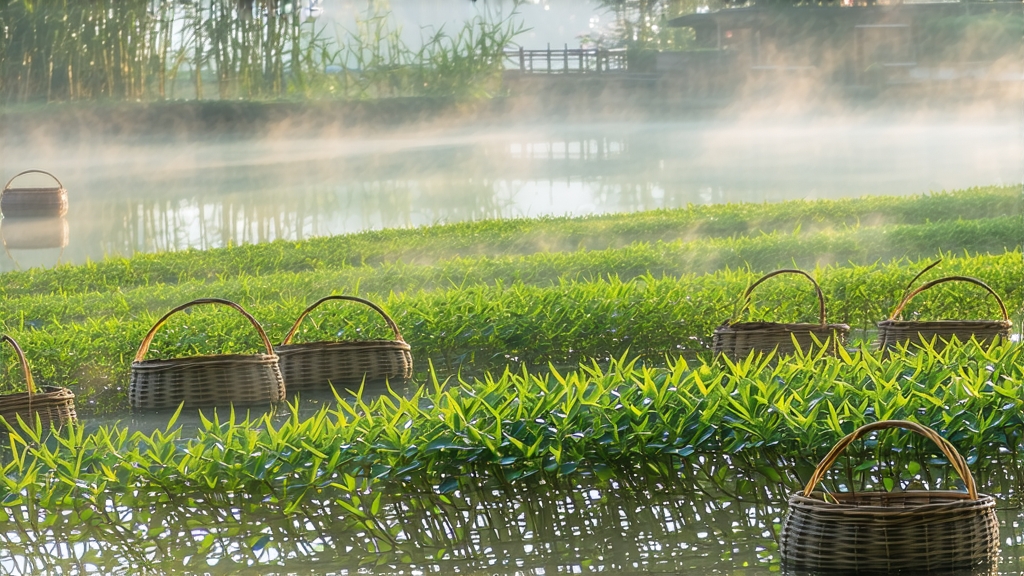
If green tea is the living memory of China, then Longjing—often spelled Lung Ching in older texts—is the verse every Chinese child learns by heart. Named after the “Dragon-Well” spring that once served the imperial court in Hangzhou, this flat, jade-green leaf has been celebrated for more than twelve centuries, yet it still feels astonishingly contemporary to anyone who tastes it for the first time. Its gentle, almost buttery sweetness carries the cool breath of West Lake’s morning mist, while its faint, roasted chestnut note speaks of the artisan’s hand cradling iron woks hotter than a pizza oven. To understand Longjing is to listen to three intertwined stories: the geology of a single hillside, the choreography of fingers on sizzling steel, and the quiet ritual of water meeting leaf in a glass.
A Brief, Legend-Studded History
The first written record dates to the Tang dynasty (618-907 CE), when the monk-poet Lu Yu listed “the water of Dragon-Well, the tea of Tianzhu” among China’s finest pairings. By the Song era, Buddhist monks on Tianzhu and Lingyin hills were already pan-firing leaves to keep their emerald color through the long canal journey to the capital. Fame crystallized under the Qing Qianlong Emperor, who, during an incognito inspection tour of Jiangnan, allegedly pocketed a handful of freshly plucked shoots from Hugong Temple. Back in Beijing he presented the leaves to his ailing mother; her swift recovery was attributed to the tea, and eighteen bushy mother-plants beside West Lake were granted imperial status. Those same shrubs still stand, fenced but unguarded, their descendants cloned across 5,000 hectares of Zhejiang province.
Terroir: Why West Lake Matters
Chinese connoisseurs insist that authentic Longjing comes only from the 168 km² micro-basin of West Lake. The hills are low—barely 200 m—but they trap fog that acts like a natural shade-cloth, slowing photosynthesis and coaxing out more theanine, the amino acid responsible for sweetness. The soil is quartz-rich sandy loam, acidic and fast-draining, forcing roots to struggle and concentrate flavor. Within the lake basin, five sub-zones are ranked like Burgundy crus: Shífēng (Lion Peak), Méijiāwǔ, Wēngjiāshān, Hǔpáo (Tiger-Running), and Lóngjǐng village itself. Shífēng yields the most sought-after leaves: tiny, orchid-shaped buds with a faint purple tinge picked before the Qingming festival, when nights are still cool enough to lock in fragrance.
Cultivars: Beyond the Name
Although “Longjing” is a place name, it is also used to label three distinct cultivars, each with its own temperament.
- Longjing #43—developed in 1972, an early-sprouting, high-yield clone that dominates commercial plantations. It offers bright asparagus notes and a lingering floral tail.
- Quntízhǒng—the old “group seed stock,” open-pollinated bushes planted before the 1960s. Leaves are broader, brews rounder, with a faint fennel sweetness.
- Wuniuzao—a wild-type strain that germinates a full fortnight earlier, risking spring frost but rewarding risk-takers with an almost mango-like aroma.
Purists can taste the difference blind: #43 is sharper, like a green apple, whereas Quntízhǒng drapes the tongue in velvety umami.
The Hand-Fired Ballet: Ten Movements in Four Minutes
Longjing is the only famous Chinese green still shaped entirely by hand in cast-iron woks. A master “tea chef” begins by seasoning the wok to 280 °C—hot enough to flash-fry garlic. One handful of just-wilted leaves is thrown in; the temperature instantly drops to 100 °C. For the next four minutes the fingers cycle through ten precise gestures: tug (抓), shake (抖), swing (搭), press (拓), grind (捺, literally “Buddha’s palm”), push (推), throw (甩), buckle (扣), clamp (压), and finally smooth (磨). The goal is to drive off 30 % moisture while locking in chlorophyll and forming the signature sword-shaped leaf. When done correctly the leaf will snap, not bend, and stand upright for a second when dropped into a glass of water—an old street-vendor trick that still delights tourists